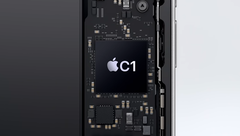Qualcomm has historically been able to take credit for Emergency SOS via Satellite as well as 5G on Apple's iPhones, as those functions were conferred by Snapdragon Xnn-series modem chipsets.
The Cupertino behemoth was able to cut Qualcomm out for the first time with the 16e, thanks to its first-gen self-developed C1 chip.
It has now been revealed to have a 7 nanometer (nm) architecture - albeit only in its transceiver (the part that allows data signals to flow to and from the chip), with a newer 4nm process for its baseband (the part of the chip that actually processes the signals).
Apple asserts that the unusual dual-architecture design is perfectly optimized to work with the 16e's A18 processor, and leads to the smoothest gameplay, browsing or uploads on the device thanks to their custom integration.
The C1 is also touted to confer improved battery life as well as performance, as it is rated to sustain the 16e through up to 26 hours of video playback per charge.
Apple also claims to have thoroughly tested the C1 for temperature resistance and resilience, as demonstrated to veteran tech blogger Andru Edwards in a world-first modem lab walk-through.
The modem has also been "rigorously" tested for the ability to receive signals from at least 180 carriers in 55 different countries.
The C1 still has its limitations, one of the more glaring of which is the absence of mmWave 5G support.
However, Apple hints that its successors might be able to correct this deficiency, and might also be found in other devices such as Macs or iPads as they improve.
The first of those next-gen chips, the "C3", is now thought to launch as part of Apple's 2027 line-up, thanks to a leak that seems to suggest that the new in-house modems might upgrade every 2 years or so.
































